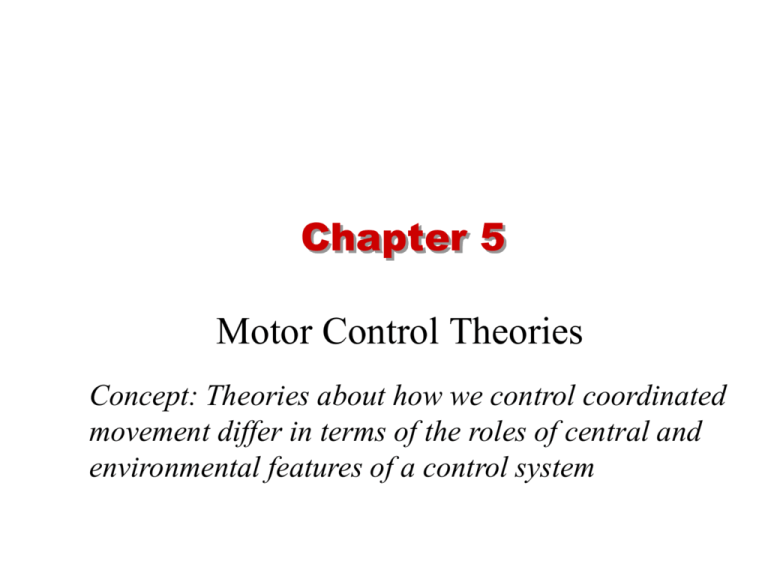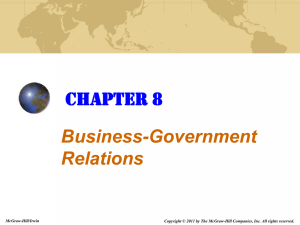
Chapter 5
Motor Control Theories
Concept: Theories about how we control coordinated
movement differ in terms of the roles of central and
environmental features of a control system
©2011 McGraw-Hill Higher Education.
All rights reserved
Theory and
Professional Practice
What is a theory?
• __________________________________________
• __________________________________________
____________________________________________
(Hawking, 1996)
Motor learning and control theories focus on:
• _________________________________________
• Providing explanations about why people perform
skills as they do
How does a theory have relevance to
professional practice?
• __________________________________________
[See Figure 5.1]
©2011 McGraw-Hill Higher Education.
All rights reserved
Motor Control Theory
Describes and explains how the
_________________ produces
coordinated movement during
_______________________________in
a variety of environments
Two important terms:
• ___________________________
• ___________________________________
©2011 McGraw-Hill Higher Education.
All rights reserved
___________________________
________________________________
________________________________
________________________________
________________________________
(Turvey, 1990)
Two parts to consider:
• Movement pattern of a skill in relationship
at a specific point of time
• Context of the environment of the head,
body, and/or limb movements so the actions
can be accomplished
©2011 McGraw-Hill Higher Education.
All rights reserved
_________________________________
_____________________________= Number of
independent elements in a system and the ways
each element can act
Degrees of freedom problem =
_______________________________________
_______________________________________
• e.g. The control of a helicopter’s flight
(described in the textbook)
Degree of freedom problem for the control of
movement:
• How does the nervous system control the many df of
muscles, limbs, and joints to enable a person to perform
an action as intended?
©2011 McGraw-Hill Higher Education.
All rights reserved
Two General Types of Control
Systems
___________________________________________
[See Figure 5.3]
Incorporated into all theories of motor control
Models of basic descriptions to show different
ways the CNS and PNS initiate and control action
________________________________________
• Function to generate and forward movement
instructions to effectors (i.e., muscles)
________________________________________
________________________________________
• Content of the instructions differs between systems
©2011 McGraw-Hill Higher Education.
All rights reserved
Differences Between
the Systems
Two differences
Open-Loop
Closed-Loop
_________________ ________________
_________________
________________
_________________
________________
_________________
________________
_________________
________________
_________________
________________
_________________
• Relies on feedback
• Does not use
feedback to continue
and terminate
movement
to continue and
terminate movement
©2011 McGraw-Hill Higher Education.
All rights reserved
Two Theories of
Motor Control
1.
2.
______________________________:
Memory-based mechanism that
controls coordinated movement
_______________________________
______________________________:
Describes and explains coordinated
movement control by emphasizing the
role of information in the environment
and mechanical properties of the body
and limbs
©2011 McGraw-Hill Higher Education.
All rights reserved
_________________________________
_________________________________
Best example comes from “Schema
Theory” by Schmidt (1988)
________________________________:
Hypothesized memory-based
mechanism responsible for adaptive and
flexible qualities of human movement
Proposed that each GMP controls
_________________________, which
are identified by common invariant
characteristics
©2011 McGraw-Hill Higher Education.
All rights reserved
Motor Program-Based
Theory, cont’d
GMP Function
• ___________________________________________
_____________________________________________
_____________________________________________
GMP Characteristics
______________________________
• Characteristics of the GMP that do not vary across
performances of a skill within class of actions
• The identifying signature of a GMP
________________________
• Specific movement features added to invariant
features to enable skill performance in a specific
situation
• ___________________________________________
_____________________________________________
©2011 McGraw-Hill Higher Education.
All rights reserved
Motor Program-Based
Theory, cont’d
Invariant features and parameters
Example of an invariant feature
• ____________________________________________
___________________________________________
Example of a parameter
• ___________________________________________a
skill
An Analogy from Music and Dance
Relative time = Rhythm (beat) of the music, (e.g. The
3 beats to a measure for a waltz)
Overall time = Tempo (The speed at which you waltz)
Regardless of how fast or slow you waltz, the
rhythm remains the same (i.e. invariant)
©2011 McGraw-Hill Higher Education.
All rights reserved
Motor Program-Based Theory:
_____________________________________
Experiment by
Shapiro et al. (1981)
Used gait characteristics
Calculated relative time
for each component at 9
speeds (3 – 12 km/hr)
•
to test prediction of
_______________________
______________________
_______________________
for a class of actions
_______________________
controlled by a GMP:
Results: Relative time
Are walking and
similar within speeds
running one or two
when walking but different
classes of action?
from speeds when running
____________________
______________________ (similar within speeds
when running)
[See Figure 5.5]
©2011 McGraw-Hill Higher Education.
All rights reserved
_________________________________
(a.k.a., Dynamical Systems)
Describes the control of coordinated
movement by emphasizing the role of
environmental information and dynamic
properties of the body/limbs
Began to influence views about motor control
in early 1980’s
Views the process of human motor control as
a complex system that behaves like any
complex biological or physical system
Concerned with identifying laws (natural and
physical) that govern changes in human
coordination patterns
©2011 McGraw-Hill Higher Education.
All rights reserved
Dynamic Pattern Theory
Concepts
Motor control system operates on the
basis of _____________________:
Behavioral changes are not always
continuous,
________________________________
________________________________
Behaviors specified by environmental
and task characteristics/conditions
________________________________
©2011 McGraw-Hill Higher Education.
All rights reserved
Dynamic Pattern Theory
Concepts: Attractors
___________________ – A stable state of the
motor control system that leads to behavior
according to preferred coordination patterns
(e.g. walking)
Characteristics of an attractor:
_________________________(e.g., relative phase)
Control parameters (e.g., speed) influence order
parameters
Minimum trial-to-trial performance variability
_________________ – Retains present state
despite perturbation
_____________________________
©2011 McGraw-Hill Higher Education.
All rights reserved
Dynamic Pattern Theory Concepts:
______________________________________
Order parameters
• Also called collective variables
• ___________________________________
____________________________________
• Enable a coordinated pattern of movement
that can be reproduced and distinguished
from other patterns
• _________________is the most prominent
of order parameters which represents the
____________________________________
____________________________________
©2011 McGraw-Hill Higher Education.
(see chapter
2) All rights reserved
Order and
Control Parameters, cont’d
______________________________
• A variable, when increased or
decreased, will influence the stability
and character of the order parameter
• ______________________________
________________________________
________________________________
_______________________________
• Provides the basis for determining
attractor states for patterns of limb
movement
©2011 McGraw-Hill Higher Education.
All rights reserved
Dynamic Pattern Theory
Concepts: Self-Organization
____________________________
• ______________________________
________________________________
________________________________
• This pattern of movement selforganizes within the characteristic of
environmental conditions and limb
dynamics
©2011 McGraw-Hill Higher Education.
All rights reserved
Attractors and Self-Organization
for Movement Coordination
Gait Transitions
Research (to be discussed
more in ch. 7) shows that
if a person begins
walking on treadmill at
slow speed
Treadmill speed increases
every few minutes
Person begins to run at a
certain speed [not same
speed for all people]
Same effect if person
begins running on
treadmill - Begins to walk
at certain speed
Swim Stroke Transitions
Research in France (2004)
14 elite male swimmers
Each trial involved a swim
velocity increase [began at
preferred velocity]
Arm-stroke analysis
showed 2 distinct arm
movement coordination
modes
Began in one mode but
abruptly began 2nd mode at
a specific swim velocity
©2011 McGraw-Hill Higher Education.
All rights reserved
Attractors and Self-Organization
for Movement Coordination, cont’d
Discuss how the two research examples on
the previous slide demonstrate the
dynamic pattern theory concepts of:
Self-organization
Control parameter
Attractors (i.e., stable coordination
states)
Non-linear behavior change
©2011 McGraw-Hill Higher Education.
All rights reserved
Dynamic Pattern Theory Concepts:
Coordinative Structures
(__________________________________________)
___________________(i.e. cooperative
groups) of muscles and joints that act
cooperatively to produce an action
• If a perturbation stops one set of muscles
from working, another works in its place
e.g. walking with a leg in a cast
Develop through practice, experience, or
naturally
©2011 McGraw-Hill Higher Education.
All rights reserved
Dynamic Pattern Theory Concepts:
______________________________________
_________________________________________
_________________________________________
The ______________________________
• The detection of critical invariant information in the
environment
The ______________________________
• The movement that becomes associated with what is
specified by the environmental information
An example
• When walking, the time to contact an object in your
pathway (specified by the perception of the changing size
of the object) determines when you initiate stepping over
the object
i.e. Your stepping action is “coupled” with your visual
perception of the object
©2011 McGraw-Hill Higher Education.
All rights reserved
Present State of the
Control Theory Issue
Currently, both the motor program-based theory
and dynamic pattern theory predominate
Research investigating each has shown that a
theory of motor control cannot focus exclusively
on movement information specified by the CNS
• Task and environmental characteristics must be also be
taken into account
Speculation exists that a hybrid of the two theories
as a compromise theory could emerge to explain
the control of coordinated movement
©2011 McGraw-Hill Higher Education.
All rights reserved






